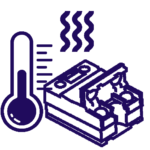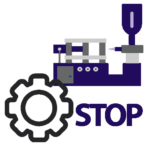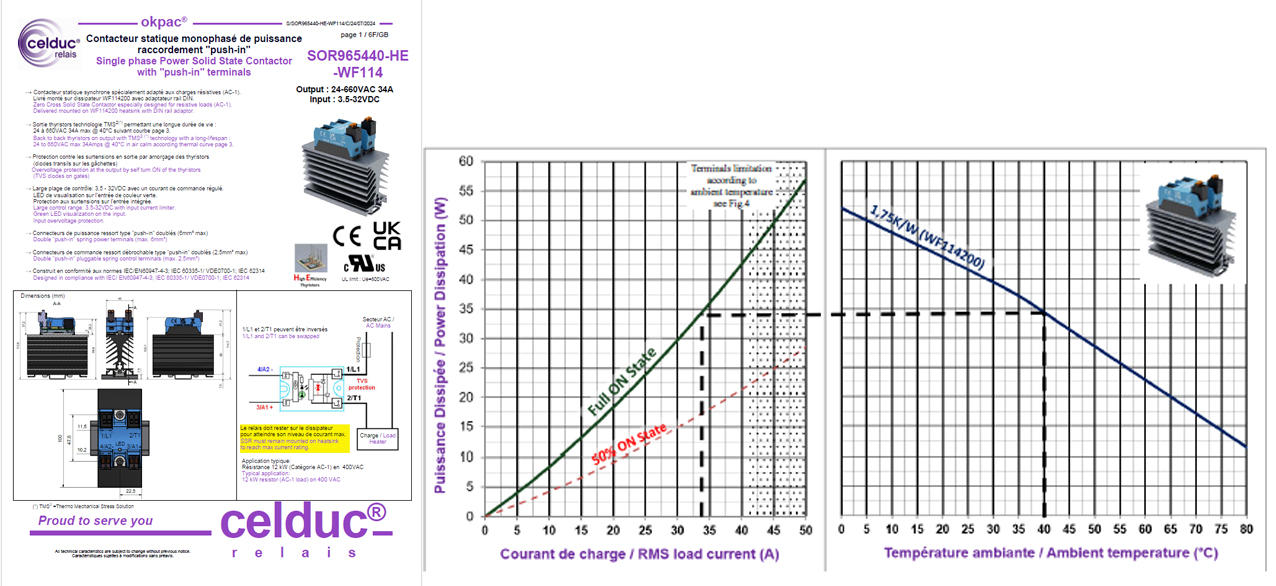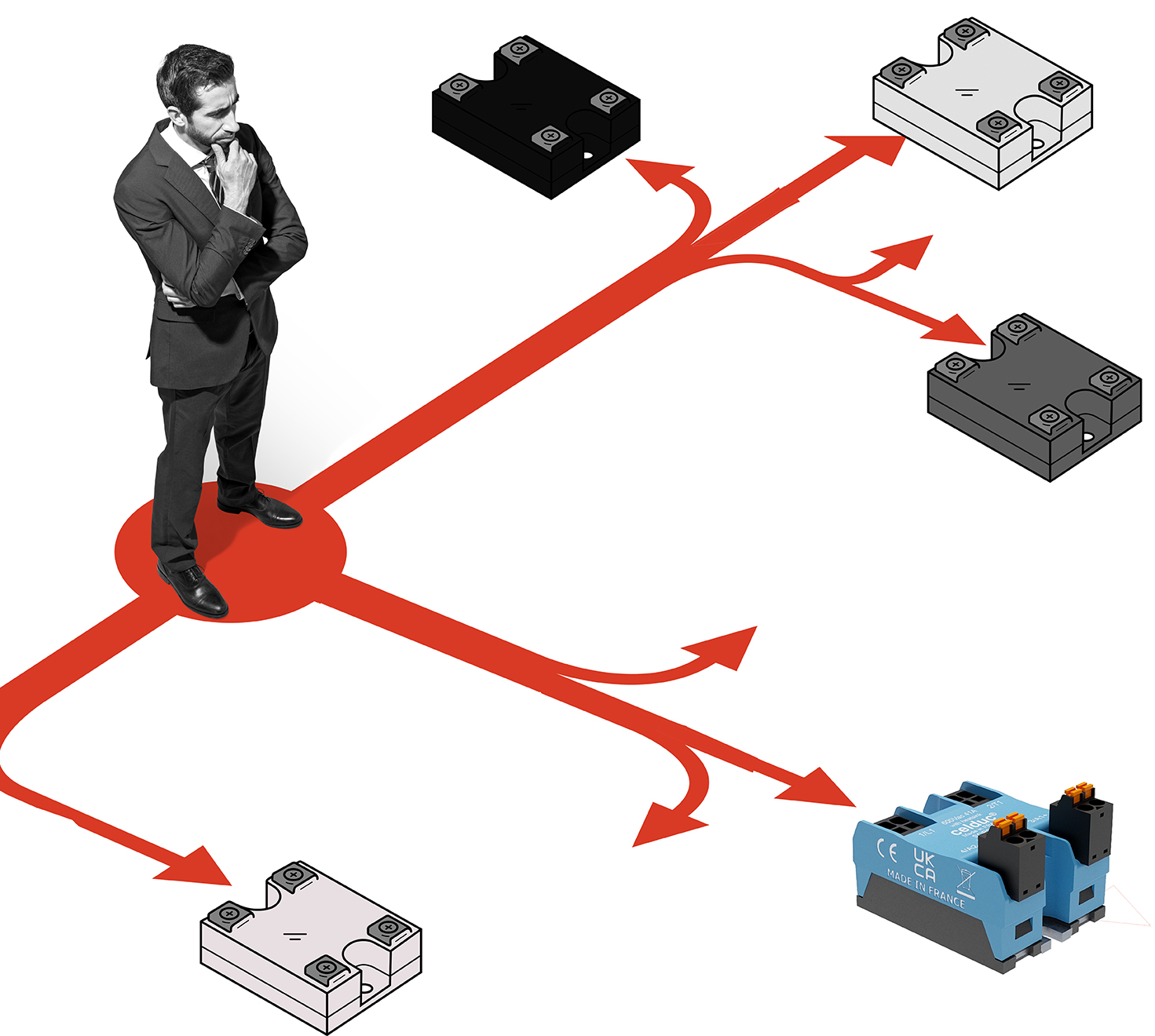Blog - EXPERTISE & INNOVATIONS - Solid State Relays - Let performance, not just price, drive your SSR selection
Choosing low-cost, poor-quality SSRs might seem like a way to save money, but it can lead to serious consequences. These products often feature hidden compromises—lower-rated components, flawed designs, and inadequate testing or certification—that put both your equipment and personnel at risk.
 Low-quality SSRs typically use under-rated internal components that struggle to handle load currents effectively. This leads to increased heat dissipation and voltage drops, causing the SSR—and potentially the connected load—to overheat, melt, or even catch fire.
Low-quality SSRs typically use under-rated internal components that struggle to handle load currents effectively. This leads to increased heat dissipation and voltage drops, causing the SSR—and potentially the connected load—to overheat, melt, or even catch fire.
Inadequate insulation and poor isolation between input and output terminals can expose users and systems to dangerous voltages and currents. The risk of electric shock, injury, or even fatal accidents increases significantly when these SSRs fail. Furthermore, without proper protections—such as against overvoltage, short circuits, or power surges—they can generate arcs or sparks that ignite flammable materials.
 Low-quality SSRs may suffer from inconsistent switching behavior, such as improper zero-crossing or random turn-on performance. These issues can create electrical noise, transient voltages, harmonics, and EMI (electromagnetic interference), negatively affecting system performance. Additionally, such relays often have shorter lifespans, leading to frequent failures, unplanned downtime, and higher maintenance costs.
Low-quality SSRs may suffer from inconsistent switching behavior, such as improper zero-crossing or random turn-on performance. These issues can create electrical noise, transient voltages, harmonics, and EMI (electromagnetic interference), negatively affecting system performance. Additionally, such relays often have shorter lifespans, leading to frequent failures, unplanned downtime, and higher maintenance costs.
 If you’re an OEM or panel builder using substandard SSRs, the fallout can extend to customer dissatisfaction, product returns, complaints, or even legal issues. A single failure can damage your reputation, customer trust, and ultimately, your bottom line.
If you’re an OEM or panel builder using substandard SSRs, the fallout can extend to customer dissatisfaction, product returns, complaints, or even legal issues. A single failure can damage your reputation, customer trust, and ultimately, your bottom line.
Opting for a well-known brand isn’t always enough. Many recognizable names simply rebrand products from lower-tier manufacturers without ensuring quality control. Solid state relay technology is highly specialized, and not every brand maintains the necessary engineering standards.
Here are six key factors to consider when selecting a quality SSR:
The control of the complete process (design, development, production, testing and marketing) has several benefits for celduc® and its customers : Independence, Flexibility, and Cost, Quality and Leadtime Management.
With decades of expertise, celduc® designs and builds its own production and quality control equipment. This in-house capability enables the company to deliver reliable, high-performance products trusted by leading industrial groups worldwide. Today, countless factories, machines, and systems operate safely and efficiently thanks to celduc® solutions.
celduc® : where engineering and manufacturing teams work side by side under one roof.
One of celduc’s key advantages lies in its integrated approach—where engineering and manufacturing teams work side by side under one roof. This close collaboration accelerates the journey from concept to product, fosters rapid innovation, and ensures exceptional quality at every stage.

Don’t rely solely on headline specifications. Analyze the datasheet carefully—especially the derating curves, which indicate how much current the SSR can handle at different temperatures. While many manufacturers quote ratings at 40 °C with resistive loads, not all follow this unofficial industry standard. Also, beware of brands that use maximum (not recommended) limits in their curves. Always include a safety margin in your calculations.

Look for third-party certifications, which show that the SSRs meet recognized international standards. This indicates that the solid-state relays have been tested and certified under the guidelines of independent and reputable organizations :
Official Third-Party Certifications:
Self-Declared Marks:
While CE is mandatory for market access, it doesn’t guarantee quality—only that the manufacturer claims to meet the standards.

Reliable SSR manufacturers provide evidence of rigorous product testing. This includes testing under extreme temperatures, vibration, humidity, electrical load cycles, and other stress conditions. Such tests confirm durability, consistent performance, and the use of high-quality internal components (e.g., Thyristors, Triacs, MOSFETs, optocouplers).
Product testing at celduc®: a key to quality and innovation
At celduc®, rigorous product testing is embedded into every stage of the development process—from sourcing components and evaluating suppliers to designing new products and simulating production. As a global leader in Solid State Relay (SSR) technology, we regularly perform lifetime tests and benchmark our products against competitors to drive innovation and ensure reliability.
There are three key reasons why product testing is essential at celduc®:
To support this, celduc® has developed specialized in-house equipment for accelerated lifespan testing. These tests are monitored through electrical measurements, X-ray imaging, microscopic inspection, and material composition analysis using X-ray fluorescence.
In some cases, deeper analysis is conducted in collaboration with external laboratories. These advanced evaluations may include tomography, acoustic imaging (Scanning Acoustic Microscopy), precision cutting, metallurgical testing (such as hardness or material composition), and chemical assessments (like contamination detection).
We also perform a range of functional tests in-house. These include analyzing how customer-specific loads affect relay performance, thermal qualification with custom or new heatsinks, and operation under extreme temperature conditions. Electromagnetic compatibility (EMC) pre-qualification is conducted to check emissions and immunity, while ingress protection (IP) and mechanical connection strength—such as resistance to pulling, bending, torque, and current-induced heat—are thoroughly tested.
When needed, we extend testing to external facilities for environmental conditions like salt spray, humidity, and rapid temperature fluctuations—especially for our proximity sensors. Additional external tests may include mechanical shock and vibration, chemical resistance to solvents, radiation exposure for nuclear or space applications, non-electrical IP testing, and short-circuit endurance.
Through this comprehensive and methodical approach to testing, celduc® ensures that every product we deliver meets the highest standards of safety, durability, and performance.

Suspiciously low prices usually signal compromised quality. Genuine high-performance SSRs cost more due to better materials, design, and testing. Always purchase from authorized distributors or reputable sellers who can guarantee authenticity and provide support, warranty, and service.
Here is the list of celduc’s authorized distributors.
Visiting the production facility is one of the most effective ways to verify the quality and reliability of Solid State Relays (SSRs). It offers clear, first-hand insight into the manufacturer’s processes, from component selection and assembly to in-house testing and final quality control. At celduc®, we take pride in managing the entire production chain internally—from engineering and design to manufacturing and inspection. This vertical integration ensures full control over every step, enabling us to maintain the highest standards of performance, consistency, and safety. A plant visit not only confirms the robustness of our production methods but also demonstrates our commitment to transparency, continuous improvement, and customer confidence.
If you’re interested in seeing our operations up close, please contact our team to organize a visit!
To get a preview, you’re also welcome to watch our factory video, which offers an inside look at our facilities and capabilities before planning your trip.
Using poor-quality SSRs may save you money upfront, but it often results in higher long-term costs, increased safety risks, and damage to your brand. By paying attention to pricing, datasheets, certifications, and testing documentation, you can make informed decisions and choose SSRs that are safe, reliable, and built to last.
When it comes to Solid State Relays, quality isn’t just an option—it’s a necessity.
